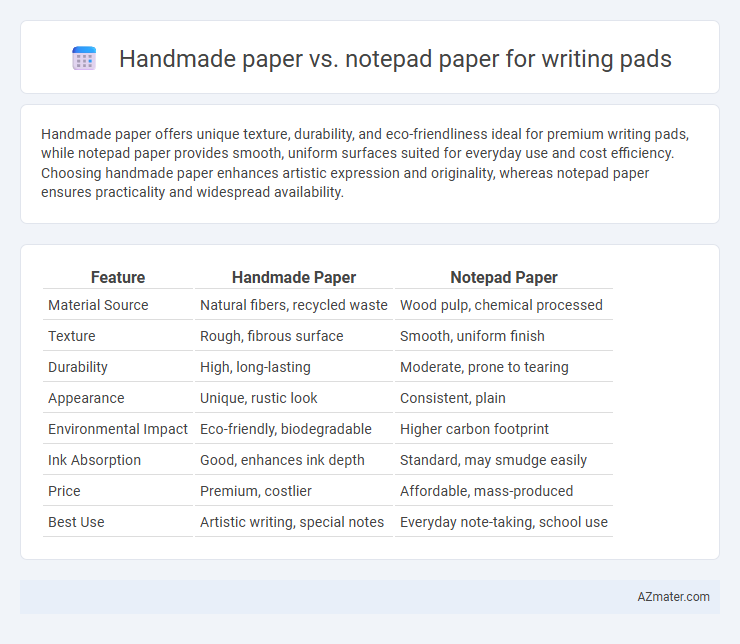Handmade paper offers unique texture, durability, and eco-friendliness ideal for premium writing pads, while notepad paper provides smooth, uniform surfaces suited for everyday use and cost efficiency. Choosing handmade paper enhances artistic expression and originality, whereas notepad paper ensures practicality and widespread availability.
Table of Comparison
| Feature | Handmade Paper | Notepad Paper |
|---|---|---|
| Material Source | Natural fibers, recycled waste | Wood pulp, chemical processed |
| Texture | Rough, fibrous surface | Smooth, uniform finish |
| Durability | High, long-lasting | Moderate, prone to tearing |
| Appearance | Unique, rustic look | Consistent, plain |
| Environmental Impact | Eco-friendly, biodegradable | Higher carbon footprint |
| Ink Absorption | Good, enhances ink depth | Standard, may smudge easily |
| Price | Premium, costlier | Affordable, mass-produced |
| Best Use | Artistic writing, special notes | Everyday note-taking, school use |
Introduction to Handmade and Notepad Paper
Handmade paper, crafted from natural fibers like cotton or recycled materials, offers a textured surface with unique absorbency ideal for artistic and premium writing pads. Notepad paper, typically machine-produced from wood pulp, provides a smooth, uniform finish suited for everyday note-taking and mass production. The distinct composition and production processes of handmade and notepad paper influence durability, texture, and writing experience in writing pads.
Material Composition and Sourcing
Handmade paper is crafted from natural fibers like cotton, linen, or recycled materials, often sourced from sustainable or artisanal suppliers, ensuring unique texture and eco-friendliness. Notepad paper typically consists of wood pulp derived from commercial forestry operations, processed chemically for uniformity and mass production. The material composition and sourcing directly influence the tactile experience, durability, and environmental impact of writing pads.
Texture and Writing Experience
Handmade paper features a distinctive textured surface with natural fibers, offering a tactile and artisanal writing experience that enhances pen grip and ink absorption. Notepad paper typically has a smooth, uniform texture designed for quick, effortless writing with minimal resistance, suitable for everyday note-taking. The uneven texture of handmade paper can enrich creativity and add character to handwritten notes, while notepad paper prioritizes practicality and speed.
Environmental Impact and Sustainability
Handmade paper is typically produced using natural fibers and minimal chemicals, resulting in lower environmental impact compared to conventional notepad paper, which often relies on energy-intensive processes and tree pulp. The biodegradability and recyclability of handmade paper contribute significantly to sustainability efforts, reducing landfill waste and pollution. Conversely, notepad paper manufacturing can involve deforestation and higher carbon emissions, making handmade paper a more eco-friendly choice for writing pads.
Durability and Longevity
Handmade paper offers superior durability due to its thicker fibers and natural production process, making it less prone to tearing and yellowing over time compared to notepad paper. Notepad paper, often mass-produced with lower-quality pulp, tends to be thinner and more susceptible to wear, reducing its longevity for frequent writing. Choosing handmade paper for a writing pad enhances the lifespan and preserves written content better under prolonged use conditions.
Aesthetic Appeal for Writing Pads
Handmade paper offers a unique aesthetic appeal for writing pads, characterized by its textured, fibrous surface and natural variations that enhance the tactile and visual experience. In contrast, notepad paper typically features a smooth, uniform finish that prioritizes practicality over artistic charm. Writers seeking a distinctive, artisanal look often prefer handmade paper for its organic beauty and ability to elevate the writing experience.
Cost Comparison and Budget Considerations
Handmade paper for writing pads generally costs significantly more due to its artisanal production process and the use of natural fibers, making it less budget-friendly than standard notepad paper. Notepad paper is mass-produced, resulting in lower prices and greater accessibility for bulk purchases, ideal for budget-conscious users or businesses. When choosing between the two, factors like quantity needed, quality preference, and overall writing experience drive the best cost-effective decision.
Ink Absorption and Smudge Resistance
Handmade paper exhibits superior ink absorption due to its natural fibers and porous texture, reducing smudging and ensuring crisp, clean writing for longer periods. Notepad paper, often machine-made with coated surfaces, tends to repel ink slightly, leading to slower drying times and increased smudge risks, especially with fountain pens or gel inks. Choosing handmade paper for writing pads enhances durability and clarity of handwriting, making it ideal for ink-heavy or detailed writing tasks.
Best Uses: Handmade vs Notepad Paper
Handmade paper offers a unique texture and durability ideal for artistic writing, calligraphy, and special occasion notes due to its absorbent fibers and eco-friendly qualities. Notepad paper is best suited for everyday note-taking, drafts, and quick reference because of its smooth surface and standardized size, enhancing ease of writing and portability. Choosing between handmade and notepad paper depends on whether the priority is aesthetic appeal and longevity or convenience and practicality.
Choosing the Right Paper for Your Writing Pad
Handmade paper offers a unique texture and absorbency that enhances the tactile experience and ink retention for writing pads, making it ideal for calligraphy and artistic projects. Notepad paper, typically machine-made and smoother, provides uniformity and affordability suitable for everyday note-taking and professional use. Choosing the right paper depends on the intended purpose, with handmade paper preferred for aesthetic appeal and durability, while notepad paper benefits efficiency and cost-effectiveness.

Infographic: Handmade paper vs Notepad paper for Writing pad
 azmater.com
azmater.com